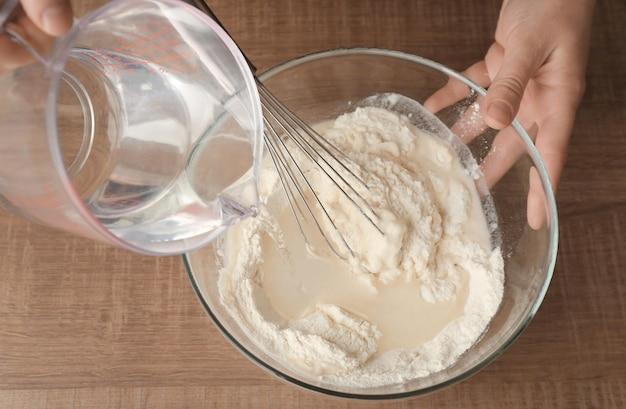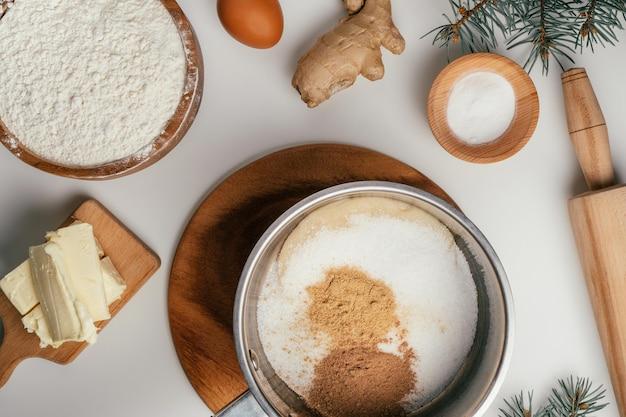Are you someone who loves to bake or cook? If so, you’ve probably come across the question of whether to mix flour with hot or cold water. Getting the mixture just right can be the key to creating delicious recipes. In this blog post, we’ll delve into the age-old debate and explore which method is best for different culinary purposes.
From making bread and thickening sauces to creating fluffy omelettes, understanding how flour interacts with water is essential. We’ll discuss common scenarios, such as how to mix flour and water without lumps, as well as explore the properties of different types of flour. So, whether you’re a novice or experienced in the kitchen, this blog post will provide you with valuable insights into the art of combining flour and water.
So, let’s find out if hot or cold water is the way to go when it comes to mixing flour and embark on a culinary adventure to enhance your skills in the kitchen.
Do You Mix Flour With Hot or Cold Water
If there’s one constant debate in the kitchen that has divided bakers and cooks for ages, it’s the temperature of the water when mixing flour. Should it be hot or cold? Well, let’s settle this once and for all.
The Hot Water Hype: Myth or Magic
Some say that using hot water can give your dough a head start, activating the gluten more quickly and resulting in a lighter, fluffier texture. While it may seem like a magical shortcut, the truth is a bit more complicated.
Myth Busting Temperature Reactions
Contrary to popular belief, hot water doesn’t magically make gluten form faster. The formation of gluten is primarily influenced by mechanical action, such as kneading. So unless you’re stirring your dough with a magic wand, hot water won’t do much to speed up the process.
The Cold Water Conundrum: Chilled or Thrilled
On the other side of the spectrum, champions of cold water argue that it helps keep the dough cool, preventing the dreaded overactivation of gluten. But does it really make a noticeable difference?
The Chill Factor
Cold water does have its advantages. If you’re working with a particularly delicate dough, like puff pastry or pie crust, cold water can help keep the fats (like butter or shortening) from melting too quickly. This preserves their structure and leads to those sought-after flaky layers.
The Ultimate Truth: Warm Water Wins
Now, here’s the secret that will blow your mind: warm water is the best of both worlds! By using water in the 100–110°F range (about body temperature), you get the benefits of both hot and cold water without any drawbacks.
The Sweet Spot: Why Warm Water Works
When you use warm water, it helps activate the yeast (if you’re making bread) while also giving the gluten a little nudge in the right direction. Plus, warm water helps dissolve the flour more easily, ensuring a smooth and well-mixed dough from the get-go.
The Bottom Line
So, in the great hot vs. cold battle, warm water emerges as the clear winner. It’s the Goldilocks of dough mixing—just right. Whether you’re baking bread, whipping up pancakes, or creating a flaky pie crust, warm water is your secret weapon for achieving the perfect texture and flavor every time.
In conclusion, banish the hot and cold water myths from your kitchen and embrace the warm water magic. Your taste buds will thank you, and your baked goods will rise to new heights!
FAQ: Do You Mix Flour With Hot Or Cold Water
Welcome to our comprehensive FAQ-style article on mixing flour and water! In this guide, we’ll answer all your burning questions about how to achieve that perfect, lump-free consistency and explore some interesting facts about this culinary combination. Whether you’re a seasoned chef or a curious home cook, we’ve got you covered. So, let’s dive right in!
How do you mix flour and water without lumps
Mixing flour and water without lumps is a skill that even the most experienced cooks can struggle with. To achieve lump-free perfection, follow these steps:
- Begin by gradually adding water to the flour while whisking constantly.
- Start with a small amount of water and gradually increase it as the flour incorporates.
- Whisk vigorously in a consistent circular motion to break up any clumps.
- If stubborn lumps persist, you can use a fine-mesh sieve or a balloon whisk to further smoothen the mixture.
Which flour absorbs more water
The ability of different flours to absorb water may vary due to their varying protein content. Generally, flours with higher protein content, such as bread flour or whole wheat flour, tend to absorb more water. These flours have stronger gluten networks, allowing them to hold onto more moisture. So, if you’re looking for a dough with a higher hydration level, opt for flours with higher protein content.
Does flour dissolve in cold water
Flour does not dissolve in cold water. Instead, it forms a suspension when combined with water, creating a thick and lumpy mixture. However, given enough time, flour particles will hydrate in cold water, resulting in a more even consistency. So, if you’re patient enough, cold water can also be used to mix flour, but it might take longer to achieve the desired results.
How do you add flour to hot liquid
Adding flour to hot liquid without encountering lumps can be a challenging task. Follow these steps for a lump-free experience:
- Start by whisking the flour with a small amount of room temperature or cold liquid, such as water or broth, to create a smooth slurry.
- Gradually pour the slurry into the hot liquid while stirring continuously.
- Ensure that the slurry is well incorporated into the hot liquid to avoid any clumps.
- Keep stirring until the mixture thickens to your desired consistency.
What happens when you mix flour with vinegar
Mixing flour with vinegar might not be a common combination in most recipes, but it can have some interesting results. When flour is mixed with vinegar, the acid in the vinegar reacts with the proteins in the flour, causing it to thicken. This reaction can be particularly useful when making certain sauces or gravies, where vinegar can enhance both the taste and texture.
Can you add flour to hot water
While it’s technically possible to add flour directly to hot water, it’s not an ideal method. The hot water will cause the flour to clump together, creating a lumpy mixture that’s hard to incorporate. To achieve a smooth consistency, it’s best to mix the flour with cold or room temperature water first, creating a slurry, and then gradually add it to hot water while stirring continuously.
Can you use flour to thicken milk
Yes, flour can be used to thicken milk and create a creamy texture. To do this:
- Make a roux by melting butter in a pan and gradually whisking in flour until it forms a smooth paste.
- Slowly add milk to the roux, stirring constantly to prevent lumps.
- Continue cooking the mixture over low heat until it thickens to your desired consistency.
How do restaurants make omelettes so fluffy
Restaurants achieve those wonderfully fluffy omelettes by following a few key techniques:
- Whisk the eggs well to incorporate air and create a light texture.
- Use a non-stick pan, well-greased with butter or oil, to prevent sticking.
- Cook the omelette on medium heat and gently push the edges towards the center with a spatula as it cooks.
- Before folding the omelette, add any desired fillings or ingredients to one side.
- Fold the omelette in half and cook for a little longer to ensure the inside is fully cooked while maintaining a fluffiness on the outside.
What is flour and water called
The mixture of flour and water is commonly referred to as a “slurry” or a “paste.” This combination serves as a base for thickening sauces, soups, or gravies. It’s a versatile and essential technique in many culinary preparations.
Congratulations! You’ve now become a pro at mixing flour and water. We hope this FAQ-style guide has answered all your questions and provided you with valuable insights. Whether you’re creating sumptuous sauces or baking up a storm in the kitchen, understanding the art of flour and water is key. So go forth, experiment, and create culinary masterpieces with confidence!

